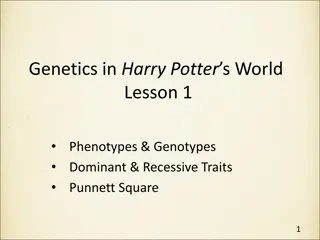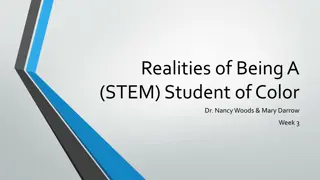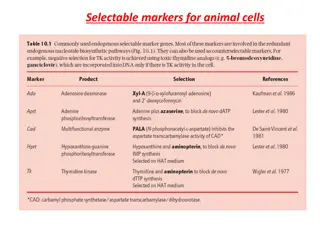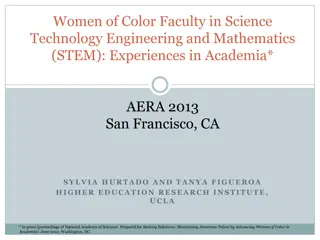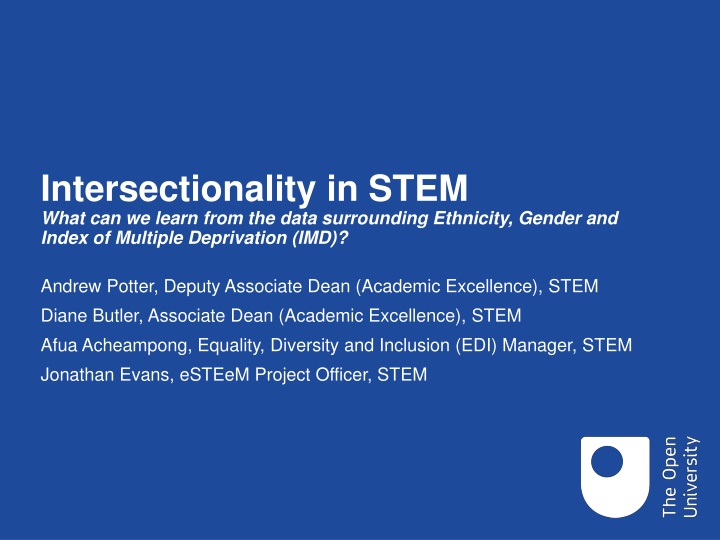
Intersectionality in STEM: Understanding Ethnicity, Gender, and Deprivation
Explore the intersectionality in STEM through analyzing data on Ethnicity, Gender, and Index of Multiple Deprivation (IMD). Learn from the insights presented by experts in the field to address intersectional issues effectively.
Download Presentation

Please find below an Image/Link to download the presentation.
The content on the website is provided AS IS for your information and personal use only. It may not be sold, licensed, or shared on other websites without obtaining consent from the author. If you encounter any issues during the download, it is possible that the publisher has removed the file from their server.
You are allowed to download the files provided on this website for personal or commercial use, subject to the condition that they are used lawfully. All files are the property of their respective owners.
The content on the website is provided AS IS for your information and personal use only. It may not be sold, licensed, or shared on other websites without obtaining consent from the author.
E N D
Presentation Transcript
Intersectionality in STEM What can we learn from the data surrounding Ethnicity, Gender and Index of Multiple Deprivation (IMD)? Andrew Potter, Deputy Associate Dean (Academic Excellence), STEM Diane Butler, Associate Dean (Academic Excellence), STEM Afua Acheampong, Equality, Diversity and Inclusion (EDI) Manager, STEM Jonathan Evans, eSTEeM Project Officer, STEM
Intersectionality in STEM Introduction We present some data which looks at intersectionality between: Gender and Ethnicity Ethnicity and Index of Multiple Deprivation (IMD). We will look at data: On a module level SDK100 Science and health: an evidence-based approach SK299 Human biology On a Board of Studies level The School of Mathematics and Statistics We will consider: How useful the data is in understanding intersectionality What approaches we can take to investigate and address intersectional issues 2
Intersectionality in STEM Caveats We will look at the pass rate for students. (APS also looks at good pass rate, but this is not considered here.) The graphs show the pass rate for students, split by protected characteristic. Each chart shows the pass rate for two single characteristics and the intersection of the two characteristics. This allows us to judge whether the combined characteristics confers a disadvantage or advantage greater than that for either of the individual characteristics. The numbers are provided to give a sense of scale. Some of the numbers are very small so some data are omitted. 3
Module SDK100: Gender and Ethnicity Student numbers in each intersection grouping Black Female 35 20 Asian Female 53 33 Mixed Female 25 12 Other Female 3 1 White Female 838 604 Male 2 0 Male 6 3 Male 2 1 Male 2 1 Male 186 123 Reg25Pcnt Pass 4
Module SDK100: Ethnicity and IMD Student numbers in each intersection grouping Black 1+2 27 15 Asian 1+2 39 22 Mixed 1+2 11 6 Other 1+2 3 0 White 1+2 443 287 3+4+5 10 5 3+4+5 19 13 3+4+5 16 6 3+4+5 2 2 3+4+5 571 432 Reg25pcnt Pass 5
Module SK299: Gender and Ethnicity Student numbers in each intersection grouping Black Female 20 14 Asian Female 32 23 Mixed Female 9 7 Other Female 5 2 White Female 607 451 Male 3 3 Male 8 5 Male 6 4 Male 2 1 Male 145 112 Reg25Pcnt Pass 6
Module SK299: Ethnicity and IMD Student numbers in each intersection grouping Black 1+2 15 12 Asian 1+2 21 11 Mixed 1+2 8 7 Other 1+2 3 2 White 1+2 272 186 3+4+5 6 4 3+4+5 17 14 3+4+5 5 2 3+4+5 4 1 3+4+5 469 367 Reg25pcnt Pass 7
Mathematics and Statistics Board of Studies: Gender and Ethnicity Intersection of Ethnicity and Gender for the School of Mathematics and Statistics Black Male 300 168 Asian Male 524 357 Mixed Male 208 134 Other Male 91 73 Unknown Male 268 191 White Male 7004 4869 Female 152 98 Female 322 231 Female 109 75 Female 53 31 Female 111 81 Female 4030 2860 Reg25% Pass 8
Intersectionality in STEM Conclusions and Next Steps Conclusions Hiding behind these data are highly complex problems that cannot be solved by analysis alone. Intersectional analysis helps research teams to focus efforts. What questions should be asked? Whom should we ask? Scholarship of Teaching and Learning Understanding awarding gaps for disabled and black LHCS students at Level 1, Carol Midgley and Jane Loughlin Understanding how our assessment contributes to retention and awarding gaps for black students on LHCS modules, Jane Loughlin, Duncan Banks and Eleanor Crabb Other initiatives STEM Inclusive Curriculum Project Decolonising the Curriculum Through the History of Mathematics 9
THANK YOU Andrew.Potter@open.ac.uk Diane.Butler@open.ac.uk













